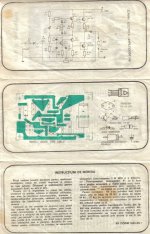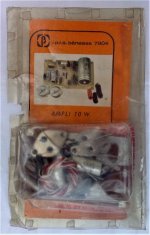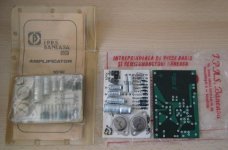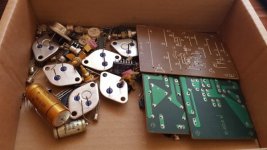Just for fun, since you talked about 2n3055's , This was sold as a kit in Romania, in the 90's . I was to young back then (born in 96') , but, I built it too long time ago, for fun.
Attachments
@anatech - More or less back on topic here, I thought about it a bit and I think for generating curves on my power devices it should be doable using just a standard socket with a clip for the collector (TO3 packages). Use a step current from 1mA to a max of 20 amps max - a step size of 250 mA above 1A and smaller below. The whole scan should take around 250mS or so max with only 20 to 40mS at any significant power - shouldn't raise the die temp much in that time but should give plenty of data points to generate a good curve as is, generate a polynomial if more detail is needed. Make runs at various values of VCE with a wait between for cooling if desired. That's the way I do my small signal devices but I was thinking I would have to deal with more dissipation than I actually would - I'm using a MAX11152 for the ADC so there is plenty of bandwidth available to speed up the process.
Thoughts/ suggestions / comments? I'm sure there is something I'm missing 🙄
Hal
Thoughts/ suggestions / comments? I'm sure there is something I'm missing 🙄
Hal
To clarify, just measure the low values of IC and it should be easy enough to get enough of an idea of the hFE curve to approximate the desired higher current steps, adjusting the curve on the fly as it is done. Probably free a bit of Magic Smoke in the process of finding a good algorithm...
Hi Hal,
The problem is that transistors are extremely temperature sensitive. It's the temperature of the die that is critical. It takes time for that heat to get to the case so you even know what the temperature of the die is. That's why "Thermaltrak" transistors were developed.
So instead of trying to fight it, I simply allow the transistors and jig to come to thermal equilibrium (measured to a temperature) and take static measurements. Those are good enough. I have a Tek 577, but it's more useful to characterize a part than to match them. It's also good at finding out weird issues with a part (as you probably know). Devices from the same lot will have very close tracking of characteristics, devices of the same part number will be close enough (or don't use that brand!).
The important thing I realised decades ago was, to compare two transistors, the silicon die must be at the same temperature. Period. That's why the expensive matched signal transistors are made on the same die. Earlier devices had them mounted together, but now the best ones are two transistors on the same piece of silicon. The physics also applies to power transistors.
I guess someone will get all fancy, measure the starting temperature and have a math model to compensate for heating based on power dissipated over the length of on-time taking into account heat loss. Then correct this in math. Too many sources of error, like air currents. I'd rather have the entire assembly self-heat to a temperature at the same ambient (so heat loss is very similar). Once it is stable you can take readings between the devices that are repeatable. If I needed precision I guess I would use an environmental chamber and basically the same setup. That blocks external air currents (furnace or air conditioning) and reduces variables further.
-Chris
The problem is that transistors are extremely temperature sensitive. It's the temperature of the die that is critical. It takes time for that heat to get to the case so you even know what the temperature of the die is. That's why "Thermaltrak" transistors were developed.
So instead of trying to fight it, I simply allow the transistors and jig to come to thermal equilibrium (measured to a temperature) and take static measurements. Those are good enough. I have a Tek 577, but it's more useful to characterize a part than to match them. It's also good at finding out weird issues with a part (as you probably know). Devices from the same lot will have very close tracking of characteristics, devices of the same part number will be close enough (or don't use that brand!).
The important thing I realised decades ago was, to compare two transistors, the silicon die must be at the same temperature. Period. That's why the expensive matched signal transistors are made on the same die. Earlier devices had them mounted together, but now the best ones are two transistors on the same piece of silicon. The physics also applies to power transistors.
I guess someone will get all fancy, measure the starting temperature and have a math model to compensate for heating based on power dissipated over the length of on-time taking into account heat loss. Then correct this in math. Too many sources of error, like air currents. I'd rather have the entire assembly self-heat to a temperature at the same ambient (so heat loss is very similar). Once it is stable you can take readings between the devices that are repeatable. If I needed precision I guess I would use an environmental chamber and basically the same setup. That blocks external air currents (furnace or air conditioning) and reduces variables further.
-Chris
Hi Bruno,
Yes, we had kits here that used obsolete parts. They were good enough to teach, but kit makers look for the least expensive parts that will work (hopefully properly). You would also find magazine articles using obsolete parts for a project (and maybe sell kits). Same reasons as above.
One thing about old part numbers. The average experimenter is familiar with the number, and likely has some in their "junk box". We used to call the bin of pulled parts, a junk box. You could also get them at recyclers, surplus parts places and other less expensive sources. Nothing wrong with that. Back then we didn't have problems with fake parts (in the 1960s and 1970s for me).
Yes, we had kits here that used obsolete parts. They were good enough to teach, but kit makers look for the least expensive parts that will work (hopefully properly). You would also find magazine articles using obsolete parts for a project (and maybe sell kits). Same reasons as above.
One thing about old part numbers. The average experimenter is familiar with the number, and likely has some in their "junk box". We used to call the bin of pulled parts, a junk box. You could also get them at recyclers, surplus parts places and other less expensive sources. Nothing wrong with that. Back then we didn't have problems with fake parts (in the 1960s and 1970s for me).
I didn't say it is original. But there are good & bad copies. Remember semiconductor technology & manufacturing process changed drastically, transistor like 2N3055 is history now. Anyway i do not promote counterfeiting & strongly against it (I expressed this view many time in this forum) but millions of people found them useful in DIY or for their business. Btw if you see vendor like alixpress full of such parts & assembled kits. If we want 100% reliability & quality we have to pay for that because everything comes with a cost.If it SAYS Toshiba on it, and it’s NOT, it’s a fake. And I wouldn’t trust it. Made by CDIL or UTC and marked as such is different.
Last edited:
Hi NanoFarad,
Nope. If its a copy, its bad. The part either has the proper characteristics or it doesn't. If it doesn't, it is a different part (even improved) and must have a different part number. I'm sorry, but anyone who uses that stuff is throwing caution to the wind. Quite frankly, if anyone put those parts in a repair, that person is completely irresponsible.
My name goes on everything I service. If I see fakes, they are on the required parts list and I will not complete it if they are left in. That includes ECG and NTE parts.
Nope. If its a copy, its bad. The part either has the proper characteristics or it doesn't. If it doesn't, it is a different part (even improved) and must have a different part number. I'm sorry, but anyone who uses that stuff is throwing caution to the wind. Quite frankly, if anyone put those parts in a repair, that person is completely irresponsible.
My name goes on everything I service. If I see fakes, they are on the required parts list and I will not complete it if they are left in. That includes ECG and NTE parts.
Jumping back a few posts ... the 2N3055 complement was never a 2N2955. That was registered as a PNP germanium and was a low power transistor.
Some folks seem to have got confused. The plastic 3055 complements were MJE2955 or TIP2955, and the metal can of course the original MJ2955.
I checked with JEDEC and they confirmed that there has been no revision to the 2N2955 datasheet so it is still a PNP Ge.
Some folks seem to have got confused. The plastic 3055 complements were MJE2955 or TIP2955, and the metal can of course the original MJ2955.
I checked with JEDEC and they confirmed that there has been no revision to the 2N2955 datasheet so it is still a PNP Ge.
Hi, by using the word 'good' i meant close to original characteristics. If millions of people found them useful & satisfactory i'll not call such transistors bad. But there are some copies which are of no use. Anyway i didn't say anything about repair job. If someone use fake transistors for repairing that is a bad thing & people should avoid such practice. Because you are simply cheating people & ruining a good piece of engineering. I feel angry when i see such thing.If its a copy, its bad....
Mind to look at my postings #351 and #355 😉 ?Jumping back a few posts ... the 2N3055 complement was never a 2N2955. That was registered as a PNP germanium and was a low power transistor.
Some folks seem to have got confused. The plastic 3055 complements were MJE2955 or TIP2955, and the metal can of course the original MJ2955.
I checked with JEDEC and they confirmed that there has been no revision to the 2N2955 datasheet so it is still a PNP Ge.
Yes, nowadays we can find datasheets on a silicon TO-3 2N2955, and we even can buy them. But it's a fake designator, if you ask me.
Best regards!
I have a huge collection of those transistors all from different vendors. All marked the same with Made in Japan. Some without the made in Japan. Vendor to vendor the basic parameters don't match. But if comparing them from the same vendor they match. The costliest pair was Rs 500 a pair. And the cheapest Rs 80.
I have a guy who supplies amp makers in the thousands he says they prefer the one which is marked by as Minos. So I picked up a pair of those also.
Have about 4 vendors. Off the C5200 / A1943 pairs. All give different hfe numbers. But if sourced from the same vendor the numbers match well. Round 1 is which is over was to put them on a basic transistor tester and get some basic numbers.
Round 2 will be to build a dedicated transistor tester and test them one by one.
My benchmark is the ones I pulled from any old AMP. The plan is to see which ones in the market match the benchmark transistor.
The other thing Im looking into is which of these circuits provided have built in short circuit protection.
Most of the DIY kits sold in India have this extra transistor that prevents the main driver transistors from trying to put out anything if there is a short. If adding a single transistor can get me short circuit protection Im all for it.
I have a guy who supplies amp makers in the thousands he says they prefer the one which is marked by as Minos. So I picked up a pair of those also.
Have about 4 vendors. Off the C5200 / A1943 pairs. All give different hfe numbers. But if sourced from the same vendor the numbers match well. Round 1 is which is over was to put them on a basic transistor tester and get some basic numbers.
Round 2 will be to build a dedicated transistor tester and test them one by one.
My benchmark is the ones I pulled from any old AMP. The plan is to see which ones in the market match the benchmark transistor.
The other thing Im looking into is which of these circuits provided have built in short circuit protection.
Most of the DIY kits sold in India have this extra transistor that prevents the main driver transistors from trying to put out anything if there is a short. If adding a single transistor can get me short circuit protection Im all for it.
Hi, by using the word 'good' i meant close to original characteristics. If millions of people found them useful & satisfactory i'll not call such transistors bad. But there are some copies which are of no use. Anyway i didn't say anything about repair job. If someone use fake transistors for repairing that is a bad thing & people should avoid such practice. Because you are simply cheating people & ruining a good piece of engineering. I feel angry when i see such thing.
Kay,
When I said "jumping back a few posts", it was your posts I was meaning, but I did not say which numbers. I believe I may have also commented on the "2N2955" some time ago too, but I just wanted to mention that I checked with JEDEC, so anything which is not a PNP germanium in a small can is mislabelled.
There may be one or two companies selling TO-3 "2N2955"'s but they are wrongly labelled. The problem seems that, like fakes, it needs international regluations and checks to keep in check.
When I said "jumping back a few posts", it was your posts I was meaning, but I did not say which numbers. I believe I may have also commented on the "2N2955" some time ago too, but I just wanted to mention that I checked with JEDEC, so anything which is not a PNP germanium in a small can is mislabelled.
There may be one or two companies selling TO-3 "2N2955"'s but they are wrongly labelled. The problem seems that, like fakes, it needs international regluations and checks to keep in check.
NanoFarad
When you say "the 2N3055 is history now" it really depends on which device you refer to. ONSemi are still selling a device under that label.
I think you mean, like many, that the original hometaxial device RCA built is history.
As I have posted before, the epi versions were faster and are better for audio, and while I agree that new devices are better still, if anyone wishes to build a decent cheap amplifier then the 2N3055/MJ2955 or TIP versions can be used. The pairs I have in my now ageing 50W amp had fhfe's of 60kHz and gave a decent 20kHz distortion figure (<.02%) with a bandwidth over 100kHz. Nothing untoward as Self reported where 30kHz started to see the supply current increasing alarmingly. That only happened with the old (slow) RCA H-devices.
If we accept that a transistor becomes obsolete if the original manufacturer obsoletes it, then I would agree. But it is truer to say that the 2N3055H is obsolete - that was the definition of the H device once the epi devices were introduced. Is it also the case that (say) the 2N3019 or 4033 are obsolete (or even the 2N3053) when there are still some "after market" companies making devices with those labels?
NRND though, which makes them obsolescent. Semantics.
And yes, I'd still agree that you can build a better amp with e.g. 2SC5200 or MJL3281A etc. but I am saying many people might be happy with the older 3 to 4MHz devices. After all, people on these threads are still suggesting MJ15003/4, MJ21193/4 etc. (or the plastic versions) which are in that range.
When you say "the 2N3055 is history now" it really depends on which device you refer to. ONSemi are still selling a device under that label.
I think you mean, like many, that the original hometaxial device RCA built is history.
As I have posted before, the epi versions were faster and are better for audio, and while I agree that new devices are better still, if anyone wishes to build a decent cheap amplifier then the 2N3055/MJ2955 or TIP versions can be used. The pairs I have in my now ageing 50W amp had fhfe's of 60kHz and gave a decent 20kHz distortion figure (<.02%) with a bandwidth over 100kHz. Nothing untoward as Self reported where 30kHz started to see the supply current increasing alarmingly. That only happened with the old (slow) RCA H-devices.
If we accept that a transistor becomes obsolete if the original manufacturer obsoletes it, then I would agree. But it is truer to say that the 2N3055H is obsolete - that was the definition of the H device once the epi devices were introduced. Is it also the case that (say) the 2N3019 or 4033 are obsolete (or even the 2N3053) when there are still some "after market" companies making devices with those labels?
NRND though, which makes them obsolescent. Semantics.
And yes, I'd still agree that you can build a better amp with e.g. 2SC5200 or MJL3281A etc. but I am saying many people might be happy with the older 3 to 4MHz devices. After all, people on these threads are still suggesting MJ15003/4, MJ21193/4 etc. (or the plastic versions) which are in that range.
Im pretty sure 2n3055 is not obsolete. In India.
BEL is making them in India. I tried to figure out under what process. And was told they are still using the old process whatever that means. Even posted links to their web site. I have a few pair which I plan to test. Took them up to 40khz no distortion. Next time I will push them to max and see what happens.
BEL is making them in India. I tried to figure out under what process. And was told they are still using the old process whatever that means. Even posted links to their web site. I have a few pair which I plan to test. Took them up to 40khz no distortion. Next time I will push them to max and see what happens.
"old process" - that could mean some form of process which looks like the original RCA process, or one which gives a similar performance. Many companies offered similar devices - BD130, BDY20, which AFAIK were not actual RCA processing, though Thomson built under licence. The old process only worked on small diameter silicon wafers, but some companies might have kept the lines going. Or developed a process which "worked" with larger wafer sizes. If it meets the old spec it should be called 2N3055H now.
The 3055 is obsolete in the sense that there are far better choices for new design out there now. And most places that were making them have ceased production. “Obsolete” in terms of their product life cycles. In some areas of the world 2N3055’s may be a better choice, when it’s between known good 3055’s or all the fake C5200’s everyone is peddling. In some circles, especially the service business, you either get the original from ON, ST, Toshiba… or you don’t use it, period. You don’t even ness with “second source” parts like CDIL, Mospec, ISC, UTC, or heaven forbid NTE. At one time it made sense in the US to use things like the 2N3055, 2N5880, M802 - when they could be had through legitimate supply chain cheaper than the modern parts. Or when there was surplus that could be trusted. Those days are GONE. And Covid ensured it. Sure it still makes sense to play with stone knives and bear skins, if you do happen to still have a source for them or a stash of them. But that it the exception rather than the rule.
Surely wafer size has nothing to do with whether a process works! Its more to do with which process steps are supported by a line I think - after all 1 12" wafer line devoted to high density CMOS logic on Si or SOI might not be suitable for InP microwave devices, or silicon power devices which have processing on both sides of the die.
They may have the process which makes, say a 2N3055 qualified on an 8” line, 12” line, or both. The tools themselves determine which wafers size(s) they can handle. They won’t need all the process steps to make a simple epi-base discrete as they would high speed CMOS or SOI ICs. Mask feature sizes are certainly a lot different. But they may share equipment.
- Home
- Amplifiers
- Solid State
- 2N3055 inside - commercial famous amplifier models, quasi complementary power output



